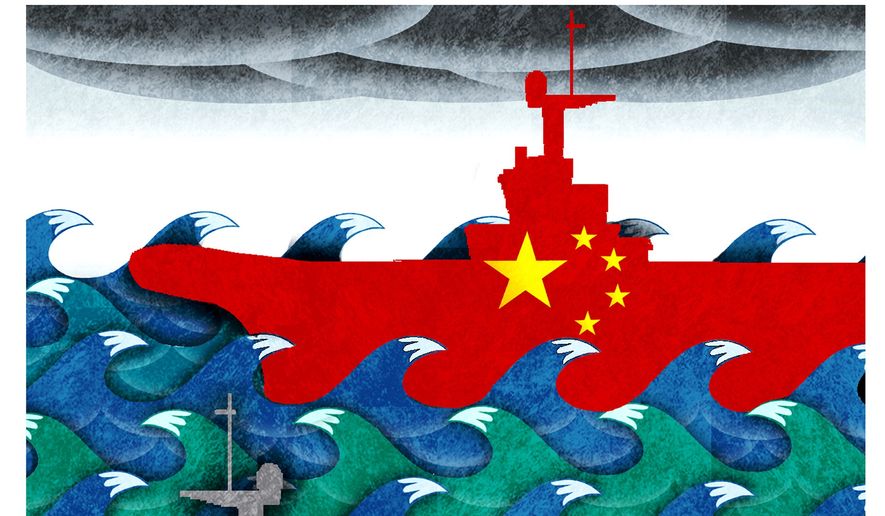OPINION:
Given recently “reelected” General Secretary Xi Jinping’s threats against Taiwan, aggressive actions along India’s borders last year, and expanding garrisons in the South China Sea, international leaders have concerns about Beijing’s intentions and its capability to act on them.
Unfortunately, many publicly available assessments claim there is no need for alarm because People’s Liberation Army (PLA) is far from ready for modern warfare. Such assessments miss two points: (1) The PLA would be fighting closer to home, and (2) it has the capacity to inflict heavy losses. More importantly, deterring such an attack is critical to America’s national security policy in Asia and that necessitates convincing Mr. Xi that the U.S. has the political will and the capability to deny him victory. Achieving that goal requires an honest assessment of America’s as well as the PRC’s strengths and weaknesses.
The “not ready” camp points to the PLA leadership’s lack of joint operations and combat experience compared with the U.S. and most U.S. allies. PLA journals express concerns about their senior leadership’s shortcomings in that regard and report mistakes made in exercises and challenges against a modern foe that understands joint operations. Those journals also reported PLA complaints about their recruits’ physical fitness and educational shortcomings. Then there is the PLA’s lack of the well-developed noncommissioned officer corps integral to Western militaries.
That camp, however, ignores a critical factor that relates directly to conflict in the western Pacific Ocean. America’s combat experiences have been gained against determined and innovative but lightly armed insurgents who lacked air defenses, air forces and fleets. China has all three. More importantly, ground combat experience does not translate directly to open ocean or even offshore air and naval combat. Any war in the western Pacific will consist primarily of combat across all military domains from cyber and space warfare to air-to-air and fleet-on-fleet actions against a technologically advanced near-peer state. Neither the U.S. nor China has recent combat experience in either of those.
Desert Storm marks the last time the U.S. faced a challenging integrated air defense system, and Iraq’s air defenders were well equipped but not well trained. Should the PLA reach American allies’ shores, U.S. ground combat experience should make the difference, although that experience was not gained fighting a modern combined arms force equipped with tanks and artillery. Finally, America’s military leaders also speak of their recruits’ lack of physical fitness, educational shortcomings and self-discipline.
The Chinese navy now outnumbers the U.S. Navy in the western Pacific, particularly when anti-ship ballistic and cruise missiles (ASBMs and ASCMs) are calculated. China has increased its fourth-generation naval surface warship inventory sixfold in 12 years, tripled its aircraft carrier force in 10 years and modernized its submarine force. Moreover, the PLA is working intensely to master joint military operations. In 2021, it integrated anti-ship ballistic missiles into a naval exercise. That required coordination between a theater combatant command, the naval service and the PLA Strategic Rocket Force.
That doesn’t mean the PLA has mastered such operations, but as the world saw in August of this year, they have integrated the capability into their exercises and probably into their war plans. In addition, one of the Central Military Commission’s new vice chairmen, Gen. He Weidong, is a former theater command who oversaw joint force exercises, operations and planning. In fact, he reportedly directed those August exercises.
Then there is the aforementioned matter of PLA journal comments about their shortcomings and problems in their exercises and war games. U.S. war game results report similar challenges against nominal PLA opponents. The reality is that every military trains against exercise enemies with “worst case” capabilities. The logic is simple. Training to fight a giant heavyweight makes it easier to defeat the enemy who is most likely a middleweight. The challenges encountered require solutions and often drive innovations that might not otherwise surface. All modern militaries, Russia being a recent exception, recognize that training and preparation — sweat, if you will — in peacetime will save you blood in war.
Moreover, the fact the PLA journals are discussing their problems suggests the mistakes are being studied and applied as lessons learned. Also, the PLA now does multi-day exercises at their opposing force training area in Inner Mongolia. They also conduct an equivalent to America’s “Red Flag” exercises three to six times a year. Unlike their Russian counterparts, PLA leaders recognize their shortcomings and are working to overcome them. They may not be ready today, but China’s leaders are working hard to be ready at some close future date.
The PLA is not an overwhelmingly powerful force today, but it can be against a complacent, inadequately equipped, poorly led or ill-deployed opponent. It can inflict expensive losses that can seriously degrade the enemy’s political will, a critical factor in Chinese military thinking and in every American war starting with Vietnam. Finally, China enjoys two advantages in a western Pacific conflict — it is closer to the combat zone and it does not have America’s global commitments.
Mr. Xi’s go/no-go decision on Taiwan will be determined by his perception of PLA versus Western capabilities and America’s political will. Deterring Chinese aggression, should that be Mr. Xi’s intentions, requires America and its allies to equip and train their forces as intensely as China is preparing the PLA. Hubris and complacency kills our own troops. Let’s avoid the mistakes of 1938-39 and 1941-42.
• Carl O. Schuster is a retired Navy captain and former director of operations at the Joint Intelligence Center at the U.S. Pacific Command.




Please read our comment policy before commenting.